-
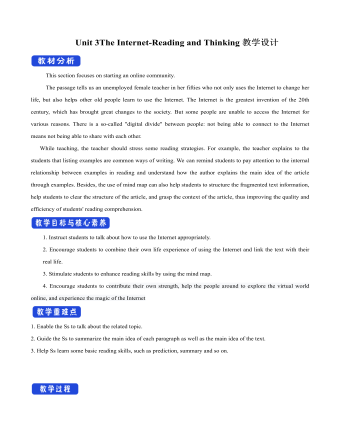
新人教版高中英语必修2Unit 3 The Internet-Reading and Thinking教案一
Paragraph 3. Jan decided to start an IT club to teach old people how to use computers and the Internet. Paragraph 4. Jan has started taking online classes to learn more about how to use the Internet to make society better. Paragraph 5. Jan’s life has been greatly improved by the Internet. Step 5: Critical thinking:(1)How do you arrange your time spent on study and the Internet? Is it reasonable? I usually surf the Internet using my mobile phone for only an hour after class, and it is reasonable for me.(2)What are your online activities? Are they safe? I chat with my friends, read news and play games. I never give away my private information so I think they are safe.Step 4: summary Much has been written about the wonders of the World Wide Web. There are countless articles (1)______(tell) us how the Internet has made our lives more convenient. But the Internet has done a lot (2)_____(much) for people than simply make life more convenient. People’s lives (3) _________________(change) by online communities and social networks so far. Take Jan for example, who developed a serious illness that made her (4)_____(stick) at home with only her computer to keep (5)___(she) company. She joined an online group (6)______ she could share problems, support and advice with others. She considered the ability to remove the distance between people as one of the greatest (7)_______(benefit). She was so inspired (8)____ she started an IT club in which many people have been helped. She has started to learn more about how to use the Internet to make society better. Her next goal is to start a charity website to raise money (9)___ children in poor countries. Jan’s life has been (10)______(great) improved by the Internet. Step 5 Homework:Review what we have learned and find out the key language points in the text.
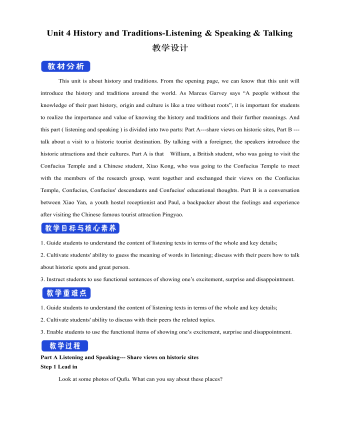
新人教版高中英语必修2Unit 4 History and Traditions-Listening&Speaking&Talking教案一
This unit is about history and traditions. From the opening page, we can know that this unit will introduce the history and traditions around the world. As Marcus Garvey says “A people without the knowledge of their past history, origin and culture is like a tree without roots”, it is important for students to realize the importance and value of knowing the history and traditions and their further meanings. And this part ( listening and speaking ) is divided into two parts: Part A---share views on historic sites, Part B ---talk about a visit to a historic tourist destination. By talking with a foreigner, the speakers introduce the historic attractions and their cultures. Part A is that William, a British student, who was going to visit the Confucius Temple and a Chinese student, Xiao Kong, who was going to the Confucius Temple to meet with the members of the research group, went together and exchanged their views on the Confucius Temple, Confucius, Confucius' descendants and Confucius' educational thoughts. Part B is a conversation between Xiao Yan, a youth hostel receptionist and Paul, a backpacker about the feelings and experience after visiting the Chinese famous tourist attraction Pingyao.1. Guide students to understand the content of listening texts in terms of the whole and key details; 2. Cultivate students' ability to guess the meaning of words in listening; discuss with their peers how to talk about historic spots and great person.3. Instruct students to use functional sentences of showing one’s excitement, surprise and disappointment.1. Guide students to understand the content of listening texts in terms of the whole and key details; 2. Cultivate students' ability to discuss with their peers the related topics.3. Enable students to use the functional items of showing one’s excitement, surprise and disappointment.
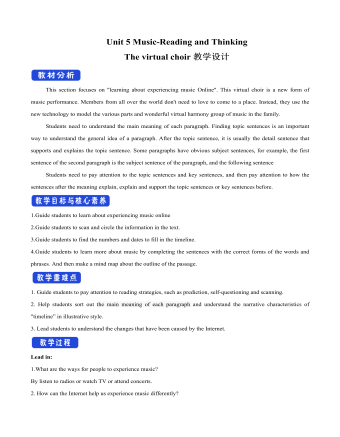
新人教版高中英语必修2Unit 5 Music-Reading and Thinking教案一
This section focuses on "learning about experiencing music Online". This virtual choir is a new form of music performance. Members from all over the world don't need to love to come to a place. Instead, they use the new technology to model the various parts and wonderful virtual harmony group of music in the family. Students need to understand the main meaning of each paragraph. Finding topic sentences is an important way to understand the general idea of a paragraph. After the topic sentence, it is usually the detail sentence that supports and explains the topic sentence. Some paragraphs have obvious subject sentences, for example, the first sentence of the second paragraph is the subject sentence of the paragraph, and the following sentenceStudents need to pay attention to the topic sentences and key sentences, and then pay attention to how the sentences after the meaning explain, explain and support the topic sentences or key sentences before.1.Guide students to learn about experiencing music online2.Guide students to scan and circle the information in the text.3.Guide students to find the numbers and dates to fill in the timeline.4.Guide students to learn more about music by completing the sentences with the correct forms of the words and phrases. And then make a mind map about the outline of the passage.1. Guide students to pay attention to reading strategies, such as prediction, self-questioning and scanning.2. Help students sort out the main meaning of each paragraph and understand the narrative characteristics of "timeline” in illustrative style.3. Lead students to understand the changes that have been caused by the Internet.
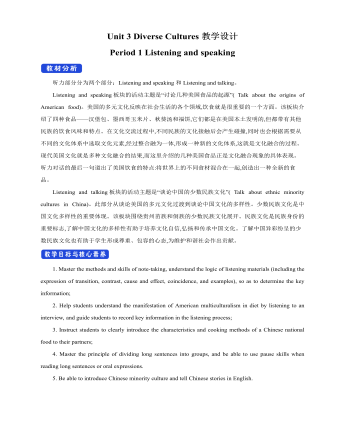
新人教版高中英语必修3Unit 3 Diverse Cultures教学设计一
Activity 81.Grasp the main idea of the listening.Listen to the tape and answer the following questions:Who are the two speakers in the listening? What is their relationship?What is the main idea of the first part of the listening? How about the second part?2.Complete the passage.Ask the students to quickly review the summaries of the two listening materials in activity 2. Then play the recording for the second time.Ask them to complete the passage and fill in the blanks.3.Play the recording again and ask the students to use the structure diagram to comb the information structure in the listening.(While listening, take notes. Capture key information quickly and accurately.)Step 8 Talking Activity 91.Focus on the listening text.Listen to the students and listen to the tape. Let them understand the attitudes of Wu Yue and Justin in the conversation.How does Wu Yue feel about Chinese minority cultures?What does Justin think of the Miao and Dong cultures?How do you know that?2.learn functional items that express concerns.Ask students to focus on the expressions listed in activity. 3.And try to analyze the meaning they convey, including praise (Super!).Agree (Exactly!)"(You're kidding.!)Tell me more about it. Tell me more about it.For example, "Yeah Sure." "Definitely!" "Certainly!" "No kidding!" "No wonder!" and so on.4.Ask the students to have conversations in small groups, acting as Jsim and his friends.Justin shares his travels in Guizhou with friends and his thoughts;Justin's friends should give appropriate feedback, express their interest in relevant information, and ask for information when necessary.In order to enrich the dialogue, teachers can expand and supplement the introduction of Miao, dong, Lusheng and Dong Dage.After the group practice, the teacher can choose several groups of students to show, and let the rest of the students listen carefully, after listening to the best performance of the group, and give at least two reasons.
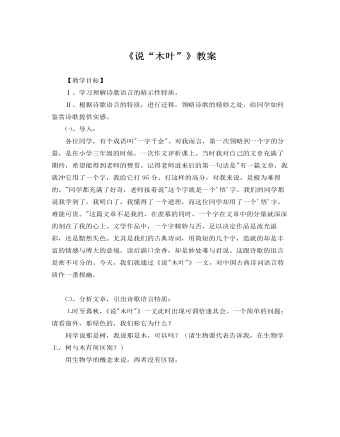
人教版高中语文必修5《说“木叶”》教案
【教学目标】Ⅰ、学习理解诗歌语言的暗示性特质。Ⅱ、根据诗歌语言的特质,进行迁移,领略诗歌的精妙之处,给同学如何鉴赏诗歌提供实感。㈠、导入:各位同学,有个成语叫"一字千金"。对我而言,第一次领略到一个字的分量,是在小学三年级的时候,一次作文评析课上。当时我对自己的文章充满了期待,希望能得到老师的赞赏。记得老师进来后的第一句话是"有一篇文章,我就冲它用了一个字,我给它打95分。打这样的高分,对我来说,是极为难得的。"同学都充满了好奇,老师接着说"这个字就是一个'悟'字。我们的同学都说我学到了,我明白了,我懂得了一个道理,而这位同学却用了一个'悟'字,难能可贵。"这篇文章不是我的,在羡慕的同时,一个字在文章中的分量就深深的刻在了我的心上。文学作品中,一个字精妙与否,足以决定作品是流光溢彩,还是黯然失色。尤其是我们的古典诗词,用简短的几个字,造就的却是丰富的情感与博大的意境。读后满口余香,却是妙处难与君说。这跟诗歌的语言是密不可分的。今天,我们就通过《说"木叶"》一文,对中国古典诗词语言特质作一番探幽。
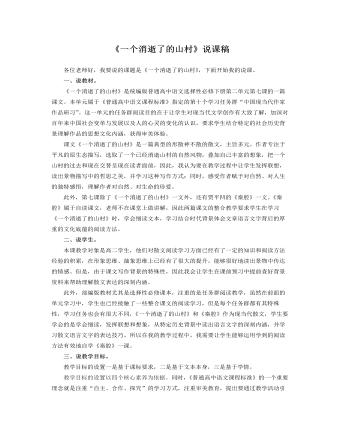
《一个消逝了的山村》说课稿 2021—2022学年统编版高中语文选择性必修下册
这几段内容传达出的是“要敬畏生命,尊重生命;更要敬畏大自然,尊重大自然,爱护大自然”的主旨内涵,因此让学生通过自由朗读的方式,再次体会冯至对这个消逝了的山村的细致的美好的描绘,感悟冯至传达出的对生命,对自然的理解和思考。5.最后一个自然段的解读依然是交给学生,先齐读课文,再让学生自主分享自己的体会或疑惑。但在这一环节我也设计了两个我认为必须解答的两个问题,一是怎么理解“在风雨如晦的时刻”;二是“意味不尽的关联”是指什么。我认为这两个问题一个涉及到写作背景,一个涉及到对全文主旨的一个整体把握,能够进一步帮助学生理解散文的深刻内涵和主旨,让学生有意识的在阅读散文过程中通过背景知识进行理解。既尊重学生的个性化解读,又能够让学生有意义学习,完成预设的教学目标。如果学生没有提到这两处,那我就需要做出补充。
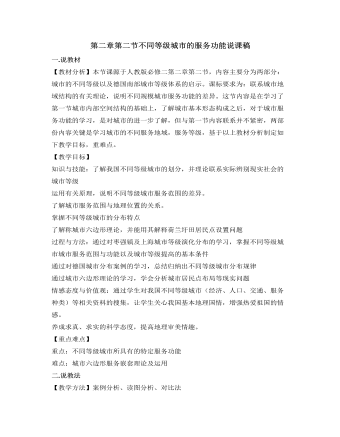
人教版高中地理必修2第二章第二节不同等级城市的服务功能说课稿
【教学目标】知识与技能:了解我国不同等级城市的划分,并理论联系实际辨别现实社会的城市等级运用有关原理,说明不同等级城市服务范围的差异。了解城市服务范围与地理位置的关系。掌握不同等级城市的分布特点了解称城市六边形理论,并能用其解释荷兰圩田居民点设置问题过程与方法:通过对枣强镇及上海城市等级演化分布的学习,掌握不同等级城市城市服务范围与功能以及城市等级提高的基本条件通过对德国城市分布案例的学习,总结归纳出不同等级城市分布规律通过城市六边形理论的学习,学会分析城市居民点布局等现实问题情感态度与价值观:通过学生对我国不同等级城市(经济、人口、交通、服务种类)等相关资料的搜集,让学生关心我国基本地理国情,增强热爱祖国的情感。养成求真、求实的科学态度,提高地理审美情趣。
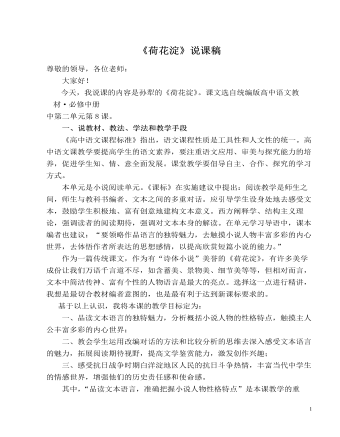
《荷花淀》说课稿 2020-2021学年统编版高中语文选择性必修中册
教师深情旁白,歌手的动情演唱,让学生会沉浸在夫妻之情、家国之爱的深深思索中,此时的课堂气氛应是沉静的。学生在这种情感体验中,一定能写出很精彩的对话]为了将这种课堂的高潮气氛不至于因学习问题的转移而跌落,我又设计了过渡语,在同学们的思绪有点紊乱中(我预想此时同学们的思绪是这样的),教师说:毕竟,藕断丝连的妇女们,对丈夫的不辞而别心存依恋。或许她们还有许多悄悄话还未来得及向自己心爱的丈夫表白;或许她们为丈夫的安全茶饭不思;或许她们有一日不见,如隔三秋的感觉。因此,几个青年妇女就聚在水生家里商量探夫的事。虽然我们未能参与其中,但我们可以听其声,见其人,感其情。不信请……)(这就实现了课堂教学环节的自然巧秒过渡,也同样展示了我的上课风格)
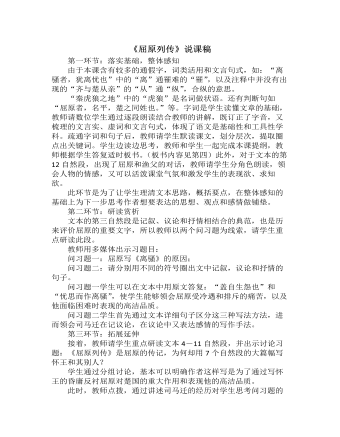
《屈原列传》说课稿 2021—2022学年统编版高中语文选择性必修中册
第一环节:落实基础,整体感知由于本课含有较多的通假字,词类活用和文言句式,如:“离骚者,犹离忧也”中的“离”通罹难的“罹”,以及注释中并没有出现的“齐与楚从亲”的“从”通“纵”,合纵的意思。 “秦虎狼之地”中的“虎狼”是名词做状语。还有判断句如“屈原者,名平,楚之同姓也。”等。字词是学生读懂文章的基础,教师请数位学生通过逐段朗读结合教师的讲解,既订正了字音,又梳理的文言实、虚词和文言句式,体现了语文是基础性和工具性学科。疏通字词和句子后,教师请学生默读课文,划分层次,提取圈点出关键词。学生边读边思考,教师和学生一起完成本课提纲,教师根据学生答复适时板书。(板书内容见第四)此外,对于文本的第12自然段,出现了屈原和渔父的对话,教师请学生分角色朗读,领会人物的情感,又可以活泼课堂气氛和激发学生的表现欲、求知欲。
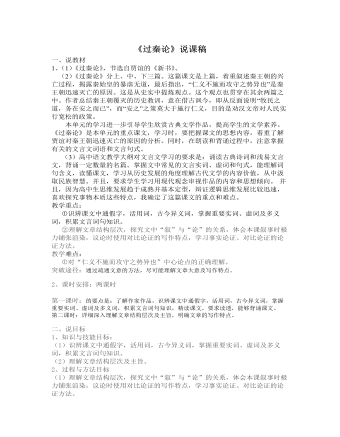
《过秦论》说课稿 2021—2022学年统编版高中语文选择性必修中册
三、教学方法为了突出重点,突破难点,完成教学目标,选择行之有效的教学方法是非常关键的。根据课程标准的要求和本节课的特点,为了关注学生的个体差异和不同的学习需求,充分调动学生学习的积极性,培养学生阅读和分析文章的能力,我主要采用以下的教学方法:1、悬念导入法。用悬念导入能激发起学生对文言文阅读的兴趣,充分调动学生学习的主动性。2、根据教师主导作用与学生主动性相结合的原则,选择了以语言传递信息为主的方法,讲授法。四、学法通过初中的学习,学生对古文知识已经有了一定的掌握,但是对这种古代散文比较少见,特别是叙史和议论结合的写法更是陌生。所以学习这篇课文的时候,通过反复地诵读,分析句型,对比句型的意思,达到疏通文意,这样,学生通过朗读理解法、质疑提问法、自主讨论探究法能复述课文,了解文章层次,理解文章主旨含义。
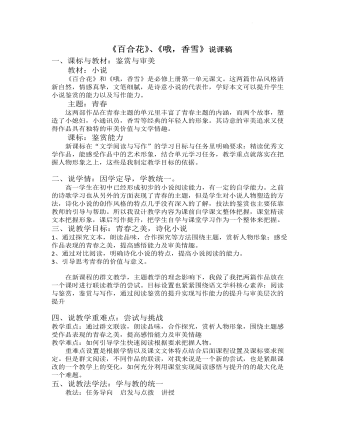
《百合花》《哦,香雪》说课稿 2022-2023学年统编版高中语文必修上册
1、导入:青春之美,弥足珍贵,青春的价值又各不相同,如果革命之志是毛泽东青春的美好,那蓬勃的创造力就是郭沫若的青春之歌,如果奉献与牺牲是闻一多青春的价值,那么自由就是雪莱青春的底色,我们前两节课遨游在诗歌的天空,那么我们这节课我们要来到小说的园地,看看青春在这片小说的沃土里展现怎样的颜色。目的:创设诗意,进入情境,延继单元主题,引出学习内容2、学习任务一:预习检查,概括情节目的:检查预习成果,落实整体感知把握主旨的课前学习任务。3、学习任务二:情境探究:品人物悟青春之美假设我校文学社正在举办“文学中最美的青春人物”评选活动,让同学在《百合花》与《哦,香雪》中推选出最能体现青春美好的人物,还需要附上简短的推荐理由以便评委组评议。谁最美?大家为此争论不休,如果你也参与推荐,那你觉得谁才是最美的青春人物?你会为他写上怎样的推荐理由?(思考提示:依据表格内容思考并完成表格,小组内交流3分钟,推选代表回答)
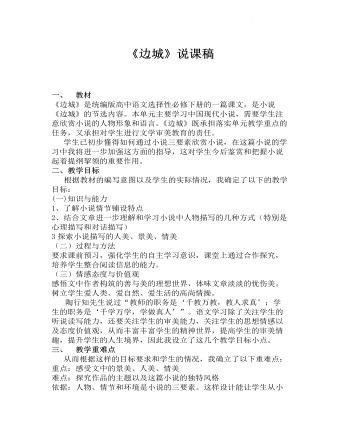
《边城》说课稿2021-2022学年统编版高中语文选择性必修下册
(重点突破一)1、分析环境描写 探讨边城的景美?(重点突破二)2、分析人物形象 探讨边城的人性美和人情美?至此,以三要素为切入口,文章的重点已分析完毕,下一个步骤就是突破难点。第二课时首先回顾上节课所讲的内容 (5分钟)(四)(难点突破)探究主题我设计了这样两个问题:1、小说表达了什么样的主题?(5分钟)2、有人说:《边城》从头到尾都隐藏着一种淡淡的愁绪,说说你的认识?从这篇小说中你可以看出沈从文先生的哪些显著的写作特点?(15分钟)这是两个定向设问的探究题,目的性很明确,就是为了突破难点,探究文章主旨。为了帮助学生理解文章的主旨,我用多媒体向学生 介绍《边城》的写作背景,给出“边城”的解题。对于第一个题,学生的答案可能会有很多种,比如“美”“爱”“纯”“和谐”“自然”等等,只要能基本概括,理由充足即可。
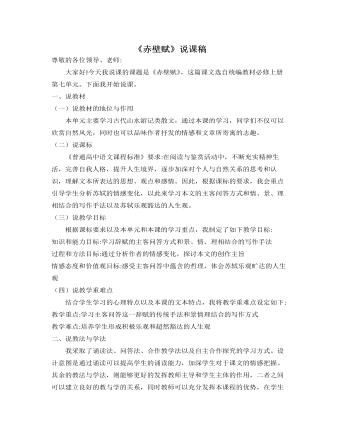
《赤壁赋》说课稿 2021-2022学年统编版高中语文必修上册
(三)赏析课文,品味哲理此环节重在解决本课的重点难点。首先,我运用问答法解决1.2两个问题。问答可以吸引学生注意,激发学生思维,培养学生概括和说话能力。通过学生的回答,即“固一世之雄也,而今安在哉”和“哀吾生之须臾,羡长江之无穷”以及“挟飞仙以遨游,抱明月而长终”这三个句子,最后明确答案:古今历史对比生悲、人生短暂和自然无穷对比生悲、理想与现实矛盾生悲;再以同样的方式分析第4段,通过教师提出问题,学生进行思考和回答这一过程,归纳出“水与月”、“变与不变”和“自然之无尽藏也”这三层哲理,最后得出是苏轼超然洒脱、乐观旷达的人生观劝慰了客人,从而达到第5段中“客喜而笑”的结果。设计两个问题的意图是让学生得以把握苏轼由疑惑沮丧到豁然开朗这一情感变化,从而更好的赏析本文。
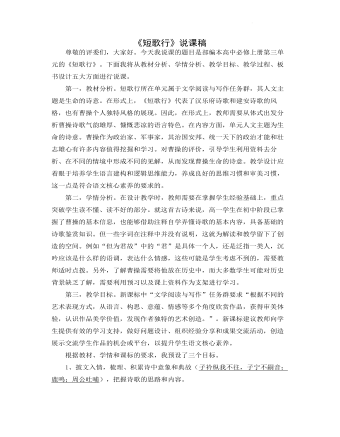
《短歌行》说课稿2022-2023学年统编版高中语文必修上册
第二课时为知人。即利用预习所查到的资料、学生之间的分享以及教师预备的材料,合作探究三个问题:曹操为何如此渴望贤才?天下归心的愿望是否实现?如何评价曹操?本课时采用创设情境的方式,从刘备、曹丕、晚年曹操等多重角度评价曹操,自领角色,利用资料有逻辑地证明自己的观点。教师出示不同学者评价,师生共同研讨评价的技巧和原则,尝试写作短小文学评论。这是解决忧的果。第三课时为回味。创设诵读比赛的情境,在比赛和评价中研讨标点符号的作用,如何读出曹操诗歌独特的特点,以及带着对曹操的认识读出自己的理解。(每组评出最佳朗读者和最佳评论员,上传优秀视频)。这是为了让学生最后读出忧。第五,板书设计。以上是我本节课教学设计的板书,体现了分析本首诗的基本思路和学习方法。
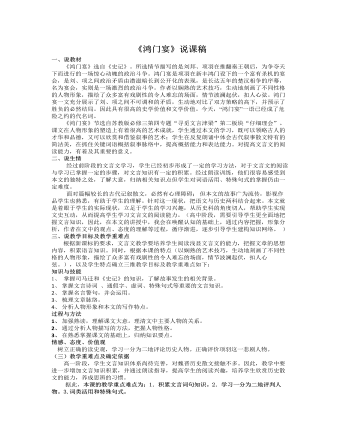
《鸿门宴》说课稿2021-2022学年高中语文统编版必修下册
(由于前一部分的铺垫,学生会比较容易地归纳出在矛盾中和对比映衬中刻画这两条,而在初中学过的《孔乙己》等小说中刻画方法也会使较多的学生联想到个性化的语言和动作是使人物栩栩如生重要方法这一条,所以学生自己就可以很快归纳出来。)作业:a.联系情节背诵第三、四段;b.写一篇读后感,谈谈你从“鸿门宴”故事得到的启示。六、说板书设计好的板书就像一份微型教案,我的板书力图全面而简明的将授课内容传递给学生,清晰直观,便于学生理解和记忆,理解文章主要内容。最上方两行分别横写标题“鸿门宴”和“司马迁”。板书重心是项羽、刘邦的人物分析:上半部分左边横写“项羽”,中间对应其主要性格“自矜功伐、为人不忍”,右边对应其形势的转化情况“主动”到“被动”;下半部分左边横写“刘邦”,中间对应其主要性格“能屈能伸、狡诈果断”,右边对应“被动”到“主动”,各自用线相连,上下形成鲜明对比。这个板书设计可以突出本文人物传记的特色和人物的鲜明性格及由此产生的形势逆转,是为教学重点的突出服务的。
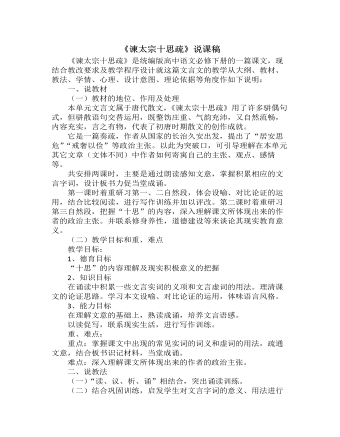
《谏太宗十思疏》说课稿 2021—2022学年统编版高中语文必修下册
三、说学法(一)学情分析经过初中阶段对文言文的学习,学生初步了解一些文言实词的意见、常见虚词的用法以及词性活用、古今异义、通假字等文言现象。但多靠机械记忆,忽略在文章内容及句义章法的理解把握前提下记忆。且较少对点滴的文言知识进行归纳整理。(二)学法指导1、圈点评注法学习课文时用一些简单醒目的符号,在字、词、句、段上勾画,标记疑问,评注阅读时的感受、体会。形成自己的圈点勾画的符号系统,使用符号时不应随意变动,以便重读复习文章。2、通过“粗读”“通读”“品读”“齐读”“个别范读”等多种形式的朗读,指导学生整体把握文章内容及思路。在此前提下,设计迁移阅读,引导学生触类旁通,学以致用,达到以读促说,以读促写。四、说教学程序(第一课时)
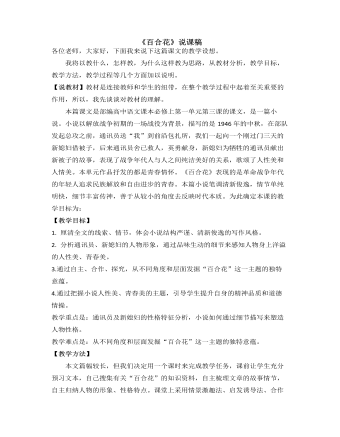
《百合花》说课稿 2021-2022学年统编版高中语文必修上册
1. 厘清全文的线索、情节,体会小说结构严谨、清新俊逸的写作风格。2. 分析通讯员、新媳妇的人物形象,通过品味生动的细节来感知人物身上洋溢的人性美、青春美。3.通过自主、合作、探究,从不同角度和层面发掘“百合花”这一主题的独特意蕴。4.通过把握小说人性美、青春美的主题,引导学生提升自身的精神品质和道德情操。教学重点是:通讯员及新媳妇的性格特征分析,小说如何通过细节描写来塑造人物性格。教学难点是:从不同角度和层面发掘“百合花”这一主题的独特意蕴。【教学方法】本文篇幅较长,但我们决定用一个课时来完成教学任务,课前让学生充分预习文本,自己搜集有关“百合花”的知识资料,自主梳理文章的故事情节,自主归纳人物的形象、性格特点。课堂上采用情景激趣法、启发诱导法、合作探究法等教学方法来引导学生学习探究,培养学生的文学鉴赏能力。
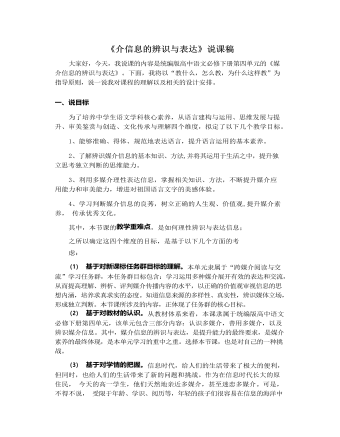
《媒介信息的辨识与表达》说课稿-2021-2022学年统编版高中语文必修下册
②癌症患者在治疗过程中,会有很大的身体损耗,而黄鳝有很好的滋补作用,适当吃一点黄鳝,既能够为患者补充营养,也能够提高患者的身体免疫力。 (来源于报纸)经过讨论交流,每一组一名同学自主发言,老师点拨,最后形成小结。看来源 要权威发布,不要道听途说看内容 要事实清晰,不要模糊遗漏看立场 要客观公允,不要情绪煽动看逻辑 要严谨准确,不要简单断言情感判断 理性判断 理性表达(四)活动三,重实践新课标提到,语文课程应引导学生在真实的语言运用情境中,通过自主的语言实践活动,积累经验,把握规律,培养能力。据此,我设计了以下贴近学生生活、可参与性强的活动。多媒体展示案例,仍然是先讨论交流,再自主发言,说出案例有哪些问题。这是某校园论坛上的一则寻物启示。
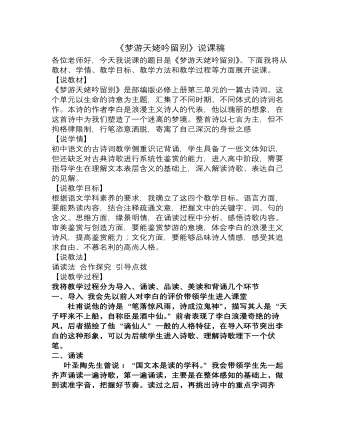
《梦游天姥吟留别》说课稿 2022—2023学年统编版高中语文必修上册
【说教材】《梦游天姥吟留别》是部编版必修上册第三单元的一篇古诗词。这个单元以生命的诗意为主题,汇集了不同时期、不同体式的诗词名作。本诗的作者李白是浪漫主义诗人的代表,他以瑰丽的想象,在这首诗中为我们塑造了一个迷离的梦境。整首诗以七言为主,但不拘格律限制,行笔恣意洒脱,寄寓了自己深沉的身世之感【说学情】初中语文的古诗词教学侧重识记背诵,学生具备了一些文体知识,但还缺乏对古典诗歌进行系统性鉴赏的能力,进入高中阶段,需要指导学生在理解文本表层含义的基础上,深入解读诗歌、表达自己的见解。【说教学目标】根据语文学科素养的要求,我确立了这四个教学目标。语言方面,要能熟读内容,结合注释疏通文意,把握文中的关键字、词、句的含义。思维方面,缘景明情,在诵读过程中分析、感悟诗歌内容。审美鉴赏与创造方面,要能鉴赏梦游的意境,体会李白的浪漫主义诗风,提高鉴赏能力;文化方面,要能够品味诗人情感,感受其追求自由、不慕名利的高尚人格。
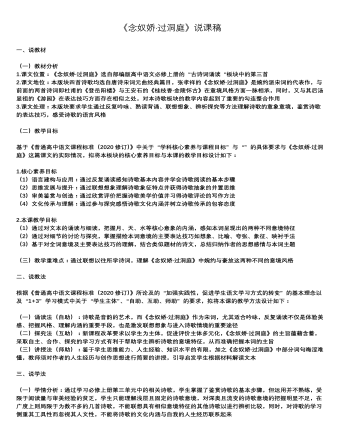
《念奴娇·过洞庭》说课稿 2020—2021学年统编版高中语文必修下册
明确:1.“孤光”象征受谗并被贬到边地的作者,表达了孤独落寞、忧谗畏讥、去国怀乡之情。2.“冰雪”运用比喻形容作者的心胸,表现了作者高洁的内在品格。3.“孤光”与“冰雪”相互映衬,月之明衬托了冰之洁,反之亦然,类似“素月”与“明河”的相互关系。4.“自照”中“自”表现了作者淡然自适与傲岸不羁的处世心态,“孤光自照”属于托物言志。问题7:分析下片第二、三句的表达效果明确:1.“短发萧骚”的细节描写表明作者年岁已高,壮志难酬,暗含凄凉惆怅之情。2.“襟袖冷”与“沧浪”暗示环境转向惊涛拍岸,风起云涌,渲染、象征险恶的仕途与坎坷的人生。3.“稳泛”反衬了作者安然自若的淡定心态、放浪形骸的伟岸风骨与超越现实的自由主义的进取精神。





















